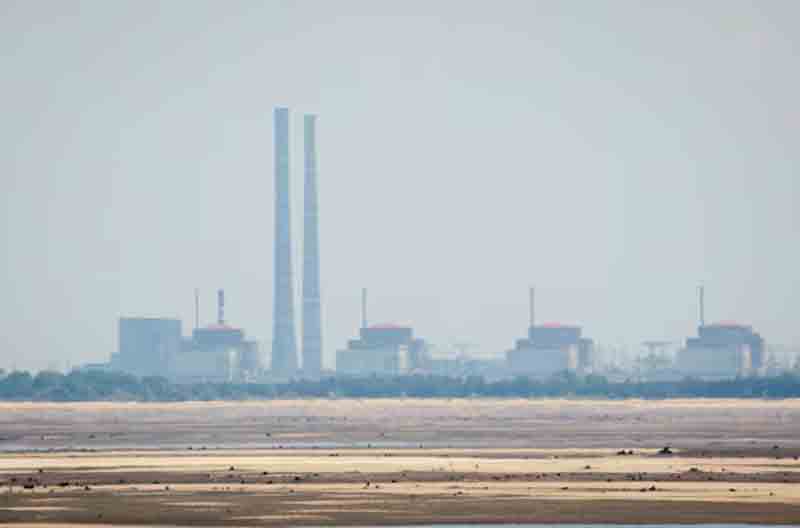Donald Trump’s proposal regarding U.S. interests taking control of Ukraine‘s largest nuclear power plant comes with a significant caveat for the man known for his deal-making skills: it could take years before any potential return on investment is realized. The extensive facility, which has been under Russian occupation since the onset of its invasion in 2022, faces numerous challenges. Its six reactors are currently in cold shutdown, the primary cooling water supply has been lost, and the condition of its equipment remains uncertain.
During a phone conversation on Wednesday, Trump suggested to President Zelenskiy that the U.S. could assist in operating, and possibly owning, Ukraine’s nuclear power plants, as stated by the U.S. presidential administration. Following the call, Zelenskiy mentioned that their discussion focused specifically on the Zaporizhzhia plant: “The president inquired if there was an understanding that America could restore it, and I affirmed that yes, if we could modernize it and invest funds.”
Two sources from the Ukrainian industry indicated that this proposal might reflect the U.S. exploring various strategies to determine what could be effective, as Trump aims to negotiate a sustainable peace agreement to swiftly conclude the conflict between Russia and Ukraine.
One source noted that the suggestion also exerted pressure on Russia by proposing a scenario in which they would need to relinquish control of the plant. The use of the term “ownership” by the Americans was seen as escalating tensions, according to the source. Zelenskiy has estimated that restoring the plant, the largest of its kind in Europe, would take approximately two and a half years.
A former senior Ukrainian official remarked, “Anything is possible with the Americans, but this is quite an unusual proposition.” They questioned, “The Americans would own it—on what basis? It belongs to Ukraine. If we were to transfer it to the U.S., what would be the terms? Would they purchase it? Would it be considered a concession? There are many unanswered questions.”
SUITCASE WITHOUT A HANDLE
Oleksandr Kharchenko, an energy analyst based in Kyiv, stated that restoring the plant to the Ukrainian power grid, as requested by Kyiv, would significantly impact energy production not only for Ukraine but also for eastern and central Europe. Prior to the conflict, the station accounted for 20% of Ukraine’s electricity generation. Ukraine had begun extensive electricity exports to the European Union just before the invasion but halted these efforts when Russia targeted its infrastructure with missiles and drones.
Despite attempts, Russian forces have been unable to connect the facility to their grid, resulting in no energy production. Kharchenko noted that restarting even a single reactor could take up to a year, while fully operationalizing the entire station might require up to four years due to various challenges. One major issue is the loss of water access from the now-drained Kakhovka reservoir, which occurred after the hydroelectric station and dam were destroyed in 2023, prior to Ukraine’s counteroffensive.
Currently, the nuclear facility is sourcing water from a cooling pond, but the water levels are declining. Engineers from Ukraine’s energy ministry believe that the water shortage may limit the plant to restarting only two of its six reactors for electricity generation. Furthermore, they estimate that it would take at least a year to resume even these limited operations, as the technical condition of the plant remains uncertain. A staff member who escaped the occupation and is now residing in Kyiv informed Reuters that Ukraine has developed a comprehensive action plan for the potential reinstatement of the facility.
A staff member, who requested anonymity due to family members still living under occupation, stated that it would not suffice for Russia to merely relinquish control of the plant. The adjacent thermal power plant, also under Russian control, along with nearby areas such as the city of Enerhodar and a road connection to the Ukrainian-controlled city of Zaporizhzhia, would also be necessary, according to the worker.
However, for individuals like pensioner Olha Shyshkyna, residing in the nearby Ukrainian-held city of Zaporizhzhia, the eventual return of the plant seems plausible, as it has not been utilized by the Russian side to date. “For Russia, our nuclear station is akin to a suitcase without a handle. It is non-operational and has become merely a toy for them. For us, it holds critical importance,” she remarked.
Discover more from Defence Talks | Defense News Hub, Military Updates, Security Insights
Subscribe to get the latest posts sent to your email.





